The Nuclear Regulatory Commission (NRC) is meant to protect public safety by enforcing regulations at U.S. nuclear power plants. Every year since 2010, we've analyzed the NRC’s performance, including what went well and what needs improving.
2013 was a mixed year for the NRC. Several incidents showed the NRC can be an effective regulator, but inconsistent enforcement and several near-misses means there’s more to be done.
Safety regulations are enforced inconsistently
The NRC has, at times, proven itself an effective regulator. For example, Nebraska’s Fort Calhoun reactor was not allowed to operate until known safety issues were corrected.
Despite this precedent, two reactors at the Diablo Canyon nuclear power plant continue to operate with well-documented—and potentially severe—safety shortcomings.
Enforcing safety regulations consistently—and prioritizing public safety—should be a major goal for the NRC in 2014.
Near-misses are fewer and less severe, but still happening
U.S. nuclear power plants experienced 10 near-misses in 2013, including several power outages, a collapsed crane, disabled equipment, and three separate incidents at Washington’s Columbia Generating Station.
“Near-misses” are defined as incidents where the chances of an accident involving core damage are increased by a factor of 10 or more.
Compared with previous years, both the number of near-misses and their relative severity decreased during 2013, an encouraging trend. Stronger oversight would help decrease the number and severity of future near-misses even further.
Reactor owners need better testing processes
Many of the near-misses in 2013 involved design and operational problems that existed for years, sometimes decades.
Reactor owners are supposed to test for and prevent these issues—but clearly they’re not.
When near-misses arise, the NRC should investigate why reactor owners didn’t catch preventable problems earlier. Fixing testing and inspection processes will help reactor owners prevent future near-misses—and reduce risk to the U.S. public.




